Thursday, January 29, 2004
It's Doubled Since Grade School
This makes a total of six forms of matter. And I remember only having to learn solid, liquid and gas just 25 years ago.
Waves at HP
One of the sadder things to have watched has been the trashing of Hewlett Packard's culture. I never worked for HP but I have called on them for years as a supplier and know people who work there. HP was recognized throughout the tech industry as one of the prototypes of the modern tech company in the way they treated their workers, their open environment, and the close interaction between top management and staff.
All of that has changed, and it's becoming public. I recommend reading Fear and Loathing at HP.
What is TAM, SAM, SOM?
The first part of creating a marketing plan is to figure out the size of your market. The total market category is usually referred to as the TAM, or Total Available Market. For example, the TAM for cellphone cameras has shown significant growth over the last few years and is forecasted to penetrate about a quarter of all cellphones in 2004.
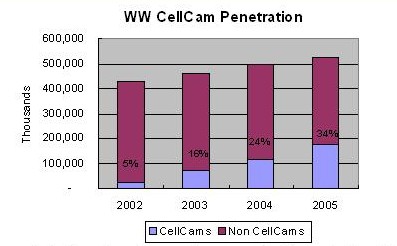
Not that the total cellphone forecast in 2004 ranges anywhere from 500 million to 550 million handsets. I have used the smaller number here (500 million) since in forecasting, it is usually better to underestimate and beat forecast than it is to overestimate and come up short. However, what is important here is really the order of magnitude and not the exact number since forecasts are rarely very accurate.
The next part of a marketing plan is to figure out your SAM, or Served Available Market. A particular product usually can't meet the specifications of 100% of the TAM, so the total market share a product can possibly penetrate is usually less than the TAM (It is possible for a SAM to be equal to a TAM, but is unusual in technical products).
This is when segmenting a market becomes useful to figure out the SAM for your product. If your SAM is less than the TAM, it can point you towards product extensions. In the end, instead of one product serving the entire TAM, you typically will have a series of products with different SAMs that together serve the entire TAM.
There are a variety of ways to segment a market (I got this question in an interview: How many ways are there to segment a market. Answer: There is no limit, but how you do it depends on what you are looking for). For the purpose of this analysis, I will use two examples: country penetration and camera resolution (the number of pixels used to capture the picture).
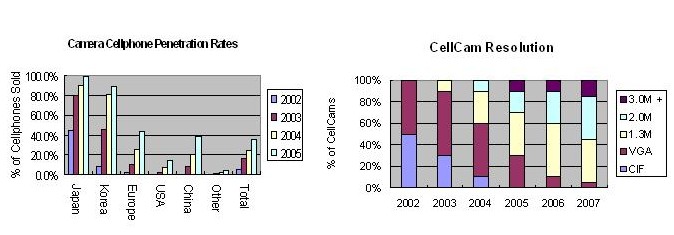
The country penetration rate is dependent on a variety of factors including migration to higher speed cell standards (2.5G and 3G), how the phones are distributed, the churn rate, and cultural factors. These are all reasons as to why in Japan and Korea cameras are essentially a standard feature. The main issue here is that the product I am marketing isn't necessarily usable in every region "as is" and may need modifications depending on cellphone standard (GSM, CDMA) and other country specific issues.
Resolution is also a big issue. I am not going to go through the definitions, but the chart shows the cellcam market moving towards higher resolutions over time (CIF is about 100K pixels and 3M is 3 million pixels).
The last step in this exercise is to figure out your SOM, or Share of Market. How many am I selling today and what is my goal for next year? Who do I sell to? SOM is calculated based on your SAM, but it should be compared to the TAM so you can tell if you should shift your product to a different SAM.
One of the interesting things about the cellcam market is that the companies that sell the most cellcams are not the ones selling the most handsets. The reason for this is the graph above showing the high penetration rates in Japan and Korea versus the rest of the world. This factor should be interesting to watch as cellcams increase penetration worldwide since it has the potential to change worldwide cellphone market share.

This last step also starts you on going through the "3 Cs", or Customers, Company and Competition.
Friday, January 23, 2004
Keeping the Door Open
As noted before, Mike was just promoted to his position, so I can't blame him for the situation here, and I DO think changes will be made in the U.S. division. The problem is this will solve only half the problem. A lot of my frustration is at HQ, which seems slow to change.
Mike asked me to stick around a year to see what happens. I turned it around: "How about I leave for a year and then we look at where we both are." Mike seemed to like that. In addition, my new office is just two miles away from my current office, so I told Mike we would do lunch every month or so. I even offered to provide marketing insight from time to time if he thought it would be helpful (he didn't respond, maybe since I didn't say if I meant for pay or not).
The bottom line is that Mike, the president of this U.S. division, and I are going to stay in touch. This keeps the door open should things not work at my new company and provides a valuable networking contact for other opportunities.
Tuesday, January 20, 2004
Fan Mail Marketing Questions
In a role as Strat Mktg Director, how much customer interaction do you have? Do you meet key customers and quarterback big sales, and handle PR and media engagements?
Or are you mostly concerned with position, strategic direction, partnerships, etc?
The short answer is: depends on the size of your company. I have been in "strategic marketing" roles that did every single activity you have listed, plus lots of others. This would be typical in smaller companies where the marketing team has ownership of figuring out the market, defining the product, doing business development and getting it rolled out and sold to customers. In this "cradle to grave" scenario, the marketing team owns the product from concept to obsolescence and overseas each part of the process including development, sales, business development, PR, etc. Perhaps there are specific departments what specialize in these areas (design, salespeople, marcomm, etc.), but the Marketing Manager owns the product and thus rides heard over the process and each team.
Currently, my "strategic marketing" role is almost exclusively the latter listing of responsibilities: positioning and strategic direction. It is almost an "Ivory Tower" sort of position, figuring out what is on the chess board and what it's going to look like in the future. I send suggestions on where to move the pieces to the Powers That Be. Sometimes they listen, usually they don't.
The job I verbally accepted today - while a marketing role - will be almost 40% sales focused, and I am expected to go out and close big design wins and key customers. There will be less input on product development and more focus on customer development.
This really branches into a whole discussion of "What is Marketing?", and I recommend you read the discussion over at Brand Mantra which goes into this topic at length.
Monday, January 19, 2004
You Can't Die In The Air
I just remembered this when I was reading the Drudge link to several people dying this weekend while on airplanes.
Interviewing for Jobs While The Imperial President Is Deposed
So I had quite an interesting few days last week with all sorts of new opportunities mixed in with office politics and intrigue:
Thursday: Interview at Company Q - This was the first interview and as I noted last week I was already doubtful because of how I perceived the culture.
The first half of the day consisted of talking to various engineering managers. It turns out that I got along with the team very
well. These are bright people working with advanced technology who
like their jobs. Several of my "interviews" just turned into bull
sessions as we just talked about technology roadmaps, potential future
products, the history of the industry and other things we had in common.
I
actually got along with the engineering team better than the actual
Hiring Manager - we got along "okay", not great. So, overall, I liked
the people and the team and think I would get along fine with my direct
manager. From a experience and career path standpoint the job is a
"good" fit, but not a "great" fit.
What's killing this deal, however, is the culture, which was exemplified with my discussions with HR.
During
my six months of unemployment during the tech bust, I came to believe
that HR was filled with hateful, incompetent, power-hungry a$$#$%s. I
thought this feeling would go away after I was hired and interviewing
from a position of strength (i.e. employed), but I find out - at least
at this company - that nothing has changed.
I got the impression
from HR that they were doing me a favor by interviewing me instead of
getting a feeling that they really wanted me to join the team. I first
cooled my heals waiting for the HR manager for about 20 minutes. The HR
manager then actually "interviewed" me, asking me details about my
previous work experience and how I would function in the position even though she had no clue about the background needed for the position.
I would use various well understood acronyms describing how my
previous experience would fit this particular position, and each time I
had to spell out what they meant and simplify the terms I was using.
So
I smiled. I said the right things. I acted interested in the position.
But the fact was that every minute I sat with HR, I became less
interested in the position. HR was the manifestation of other hints and
pointers I received throughout my interviews with engineering: this was
a highly bureaucratic, top-down organization. CYA (cover your a$$) was
a finely tuned craft at the company. It was simply a Big Company
mentality with a Big Company structure.
The interviewe ended with
HR telling me they had a few other candidates they were talking to and
they would get back to me by the end of the month. Leave your number,
maybe we'll call.
Friday: Interview at Company A
- This is the way open positions should be filled. I arrived at the
company and was immediately greeted by HR, who offered coffee and small
talk until my first interview came out of a meeting that was running
late. Turns out this was the COO, but before I met with him, the hiring
manager talked to me for five minutes, asking how I was doing and
giving me a few pointers about the COO before going in.
The COO
was relaxed and laid back. He didn't have a copy of my resume in front
of him, nor did he ask for one. He simply sat across from me and we
talked about the position, how I would manage it, and what he expected
from it in the coming year. I think he made up his mind pretty quickly
since the conversation then turned into a pitch for the company and how I
could find an exciting career path under his guidance.
I then
had two other interviews with senior management before heading out to
lunch with the team and having a final talk with the hiring manager
before being wisked away to HR, which focused mainly on benefits. The
company called me Friday night to tell me they would make an offer on
Monday.
ONE PROBLEM: The offer came in this morning and it's a
low-ball. While I expect some negotiation in salaries, I am a bit
disappointed that I have to play the game, and quite frankly, the bid
really took away a lot of the excitement I had about the position. I
basically said no and they are going back to "see what they can do", but
at this point, there is the chance that although I like the team and
feel that I am a good fit for the position, this job isn't going to
happen.
Friday Evening: The President is Dead. Long live the President!
- I had just come off the plane from my Friday interview when my phone
ringed. Someone in accounting, knowing I was out "sick", called to tell
me that the Imperial President had been "recalled". I had heard about this rumor well over a month ago, so was not too surprised about hearing it.
As predicted, Director Mike was put in charge. My first thought was "will this change my position and career at Global MegaCorp so I will want to stay?" The answer is: "probably not",
but in light of the disaster with Company Q and the ongoing
negotiations with Company A, I think I will at least look into the
situation a bit further.
Of course the resulting change in the
Presidency has other movements going on, so I will post a new org chart
later in the week after the dust settles. Right now the office is like
an ant hill that has been kicked over - everyone is scurrying around
trying not to be stepped on.
Friday, January 09, 2004
CES Overview
Coolest New Product - For me, it was the new "Multimedia Players" that were introduced from Creative Labs and Archos. These are going to be the Next Big Thing for consumers, essentially adding video and pictures to MP3 players.
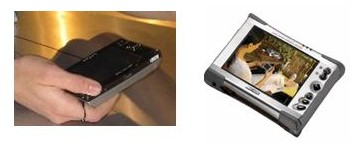
These products essentially add an LCD screen to an Apple iPod (Apple, where is yours?), so you can download movies, pictures and the like to enjoy with your music. The Creative guy in the booth claimed if you download movies using the Windows standard, you could get three full-length movies on the 80GB drive, so this could become THE thing to have for long-distance travelers. When queried about battery life, he admitted that it would be a little weak, so you would want an extra. Estimated retail price is ~$600-700. These products are not yet ready, but are being slated for mass production in the middle of the year.
These products must have the Motion Picture industry sweating. I believe swapping/downloading of movies hasn't been a big deal since most people don't watch movies on their PC, but with the introduction of a small portable device with a small, low-quality screen, I think on-line movie swapping will take off.
Most Unique Products
TV Mirror - It's a TV! It's a Mirror! It's Two Things in One! If turned off, an ordinary mirror is displayed by the LCD display (you can't tell it's an LCD), but if turned on, it becomes a TV. The main market is going to be hotel rooms and the like, although it will probably make it into a small share of people's homes.
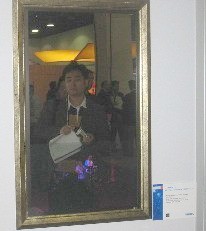
3D, No Glasses - Sharp's 3D displays were also pretty neat (no pics). You get a 3D view without the need for special glasses, although, for me, it only worked with still pictures and not video. The main market seems to be technical and scientific, although Sharp hopes to get it into consumers' hands with PC games and the like.
A Real, Virtual Keyboard - I had the chance to play with a virtual keyboard in the Panasonic booth. It is REALLY neat. The "feedback" I wondered about in this post is provided by a soft "clicking" noise. Typing on the countertop, I found I could type nearly as fast as on a keyboard. No commitment to when this will be on the market.
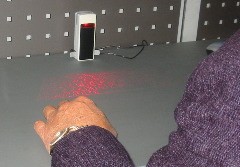
Man's New Best Friend - Sony's QRIO robot is only a demo for trade shows (they call him their "ambassador"), but it is quite impressive. He walks on two feet and has very fluid motion of his arms and legs, thanks to the help of 38 motors (he's about 18" high). Obviously this could eventually become a product, but with their AIBO robot dogs currently $1500, I don't think we will see the QRIO on the market any time soon since it is much more advanced (meaning MUCH more expensive).

Trends
The main overlying themes I noticed at the show could be grouped as follows:
The Usual: More Capacity, Smaller, Cheaper, Faster - This is the main drive of this industry and a part of my Immutable Laws of Consumer Electronics. One specific item I will point out is the move to replace the red laser in your CD and DVD players with a blue laser. Several of the major OEMs are getting their Blue Light products out of the lab, and these will hold 4x-10x the capacity of existing CDs and DVDs. Expect these to hit the market in the next year.
Flat Panel - EVERYTHING was flat panel. The tubed TV will be going the way of the black-and-white TV in the next decade. LCD's still haven't made it to the size of Plasma, but hopefully will get there soon.
Digital Broadcasting and HDTV - There was a big push by both cable and satellite providers for direct digital broadcast. And if you do that, you will need a (flat panel) High Definition TV (HDTV). And if you do that, your DVD will need to be upgraded to a High Definition DVD (HD-DVD). And if you do that, you might as well upgrade your camcorder to HD format as well. So this whole movement goes with the strategy of changing format so consumers will need to upgrade everything they have (similar things happened with tapes to CD, VHS to DVD, etc.).
Wireless Connectivity - WIFI for your PC is old news. Connecting your TV set-top box and stereo wirelessly to your PC is relatively new. I thought this would be a big push of this year's show, and while present, it was not as big as I thought it would be, so wireless consumer products are going get a slow roll-out rather than a big one.
Automotive Electronics - I am sure there were some new items in this area, but this area of the show had other man-made
Update: Master of None has a link to a video of the QRIO robot dancing, giving a good idea of its capabilities.
Tuesday, January 06, 2004
Kewel - but $100 too Expensive
The "Old" iPod on the left, new one on the right

The pic links to Apple's site, or see more at Gizmodo.
Friday, January 02, 2004
Virtual Consulting (Continued)
Today I had my first consultation, and it went quite well. I talked to an analyst at a investment company and we ended up just chatting for an hour about the state of the overall tech market (good) and about several segments and companies in particular. I confirmed some things he has already seen as well as gave him some additional areas to look into.
After the conversation I billed the consulting company, which sent me an email confirmation that payment is in process. I should note they asked for my SS#, so I don't know if they are going to withhold (unlikely) or send me a 1099-MISC next year (more likely). For this reason, I will keep track of certain expenses (internet connection?) to write off against this income so it doesn't get taxed (i.e. I will count this income as outside business income and create a schedule of expenses to write off against it).
In addition, the analyst asked for me to be set up on his permanent "panel of advisors", so he can call me direct again in the future, in which case I will bill the company again. PLUS, the consulting company asked me to put days I can be "on call" in order to increase my call/client volume.
Overall, I would say it has been a very positive experience. I am not going to get rich doing this (my billing rate isn't very high), but it looks like a good way to pull in a few bucks on the side while also creating new business contacts and keeping my mind limber about different aspects of the market.
If you wish to join you can sign up on their web site. There is no guarantee you will be accepted, but if you have an area they are interested in and have some time, this seems like a good idea.
